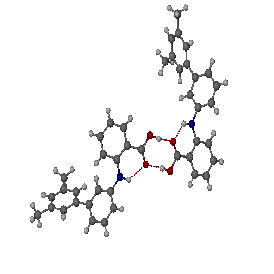

Synthetic Methodology ● Asymmetric Catalysis ● Chirality Sensing
Dynamic Stereochemistry ● Medicinal Chemistry
Research in the Wolf group is very interdisciplinary and includes various aspects of organic reaction development, asymmetric synthesis and catalysis, fluorine chemistry and C-F bond functionalization, reaction mechanism studies, green chemistry, stereochemical analysis of chiral compounds, optical sensing technology, high-throughput screening methodology and drug discovery. The widespread expertise in these highly synergistic research areas puts us in a unique position to push current frontiers in modern chemistry and in the health sciences. The Wolf group is actively involved in several collaborative drug discovery efforts, in particular in anticancer research and in the development of treatments for Parkinson’s and Alzheimer’s disease. In all these efforts, we aim to grow original ideas from the early discovery stage through the patent, publishing and commercialization processes. We firmly believe that diversity, tolerance and mutual respect are crucial for our shared success and we strive to provide an inclusive working environment that protects and lives these values every day. Selected examples of our research activities are highlighted below. For additional information, please check our publication list and twitter account. We are grateful for generous financial support from the National Institutes of Health, the National Science Foundation, the Petroleum Research Fund administered by the ACS, the Georgetown Environment Initiative, the Bone Cancer Research Trust, KeifeRx, and Merck.



Synthetic Methodology
New synthetic methods aimed at high-yielding carbon-carbon and carbon-heteroatom bond formation are developed in our laboratory. These efforts are guided by emerging mechanistic insights and systematic reaction optimization strategies. The detection, trapping and structural elucidation of key reaction intermediates and products by X-ray crystallography, in situ IR, NMR spectroscopy, mass spectrometry and other techniques together with computational analysis provide invaluable clues that we use in our methodology developments. Significant emphasis lies on the introduction of new functionalization concepts, asymmetric catalysis, fluorine chemistry and sustainable chemistry producing multifunctional building blocks that have broad synthetic utility and may serve as precursors for pharmaceuticals and natural products.

Asymmetric Catalysis
The ever-increasing demand for chiral compounds and the importance of fluorinated pharmaceuticals generate compelling motivation for the development of new synthetic methods that afford practical access to a wide variety of a variety of chiral building blocks. The introduction of new strategies that provide control of the unique stability and reactivity patterns of halogenated nucleophiles and electrophiles offers invaluable opportunities to streamline chemical synthesis of current and future drugs and to conquer new chemical space. With this in mind, we are developing new asymmetric reactions using both traditional metal catalysis and organocatalytic methodologies in conceptually new ways.

Chirality Sensing
It has become routine in academic and industrial laboratories to conduct hundreds of reactions in parallel using modern high-throughput experimentation (HTE) technology. The analysis of hundreds of asymmetric reactions, however, remains challenging as costs, time constraints, availability of only minute sample amounts from small-scale reactions and waste management issues need to be considered. The constant quest for new chiral pharmaceuticals, agrochemicals and other biologically active compounds demands analytical means that effectively support asymmetric reaction development and optimization efforts. Our laboratory has developed a variety of (chir)optical chemosensors that allow simultaneous analysis of the absolute configuration, ee and total amount of a wide range of chiral compounds based on rapid UV, fluorescence and CD measurements. With these in hand, we are introducing practical assays that fully exploit the impact of HTE and streamline asymmetric reaction screening. Our approach is compatible with modern workflow platforms, minimizes waste production and operational (consumables and labor) costs. The possibility of direct determination of yield, ee and absolute configuration using mg amounts of crude reaction mixtures (no work-up!) has been demonstrated several times by our laboratory. We have introduced machine learning tools to decipher the composition (concentration, ee and de) of mixtures containing several chiral compounds.

Dynamic Stereochemistry
Asymmetric transformations of the 1st and 2nd kind, (de)racemization, diastereomerization reactions and other stereomutations of chiral compounds play a key role across the chemical sciences and the analysis of these processes affords invaluable guidance for the development of asymmetric reactions, the design of chirality chemosensors, and drugs. We employ variable-temperature NMR spectroscopy, polarimetry, circular dichroism and chromatographic techniques, in particular DHPLC combined with computer simulation of plateau-shaped HPLC elution profiles, to determine the stereodynamic properties of atropisomers and other chiral compounds. This has been particularly helpful for the development and refinement of several of our chirality sensors and for the study of medicinally relevant compounds such as peptoids, N-aryl glycines and fluorinated compounds.

Medicinal Chemistry
We have been involved in collaborative projects aimed at understanding drug/target interactions, drug resistance mechanisms and the development of structure-activity relationships that provide guidance for systematic development of anticancer agents and other drugs. We are particularly interested in the introduction of new therapies for Alzheimer’s and Parkinson’s disease. In addition, we develop highly specific molecular probes that detect and quantify important biomarkers such as D-amino acids and other biologically important compounds.

